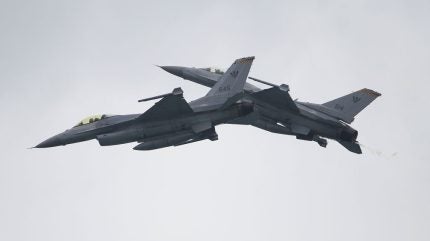
Failure in two of four pitch rate gyroscopes caused the crash of a Republic of Singapore Air Force (RSAF) F-16 fighter jet on 8 May 2024, as concluded by a RSAF investigation published 19 June.
The F-16 digital flight control computer (DFCC) was presented with ‘erroneous but similar’ readings from the failing gyroscopes, and took these inputs as “correct”, rejecting alternative readings, including the backup gyroscope.
As the DFCC manoeuvred in response to the erroneous readings, the jet became uncontrollable and the F-16 pilot ejected safely shortly after take-off.
According to the RSAF report, the F-16 gyroscopes in this crash are the same as those operated by F-16 fleets across the world. No preventative maintenance is stipulated by the manufacturer, Lockheed Martin, but faulty gyroscopes are to be replaced. The pre-flight checks detected no fault in the gyroscopes before the F-16 crash on 8 May.
The crash occurred during a routine training flight at the Tengah Air Base in western Singapore, and RSAF temporarily suspended training for the F-16 aircraft until it was safe to resume flights.
Before the training flight on 8 May that resulted in a crash, the pilot conducted a pre-flight test, and the Built-In Test did not detect any fault with the aircrafts gyroscopes, with Gyroscopes 1, 2, and 3 providing correct inputs, while Gyroscope 4 remained as a back-up.

US Tariffs are shifting - will you react or anticipate?
Don’t let policy changes catch you off guard. Stay proactive with real-time data and expert analysis.
By GlobalDataEach gyroscope is mechanical spinning rotor set within gimbals to observe rotation rates for the aircraft for Pitch, Roll and Yaw, with the observation converted to electrical signal readings for the flight computer.
At take-off, Gyroscopes 2 & 3 were degraded but gave similar inputs to one another. The DFCC treated the reading from Gyroscope 1, which was functioning correctly, as an erroneous result. Gyroscope 4 was activated, but also rejected.
The conclusion of the RSAF F-16 crash investigation finds that the gyroscopes degraded due to ‘wear and tear’ and failed during take-off. The RSAF has put in place additional preventative maintenance to the gyroscopes, periodically removing the assemblies and testing the components, going beyond the prescribed manufacturer maintenance procedures.
The release from the Republic of Singapore Ministry of Defence does not detail why the DFCC rejected readings from Gyroscope 4, the F-16’s backup gyroscope, which the RSAF does not describe as degraded, or as either providing a correct or erroneous reading.



